Janet Roberts's Blog, page 17
June 22, 2013
European Stone Festival - Lincoln
http://www.aboutnottinghamshire.co.uk/
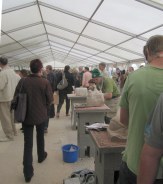 Lincoln Cathedral was the dramatic setting for this amazing event. Held annually since 1999, it is hosted in a different country each year. It was the first time the event had been held in the UK for ten years, and was with a free entry - so far too good to miss!
Lincoln Cathedral was the dramatic setting for this amazing event. Held annually since 1999, it is hosted in a different country each year. It was the first time the event had been held in the UK for ten years, and was with a free entry - so far too good to miss!
The first thing that struck me was the noise! Up to 140 masons were bashing away with hammers and chisels, with pieces of stone flying in all directions! (I was glad when someone kindly pointed out a box near the entrance full of complimentary goggles!)
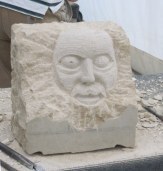
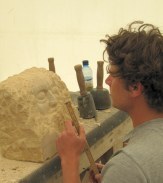 Each workstation (made of piled up breeze blocks I noticed!) was clearly labeled, and this is Liebert Benjamin carefully measuring his work. At the end of the afternoon I returned and it was absolutely fascinating to see how the works had progressed.)
Each workstation (made of piled up breeze blocks I noticed!) was clearly labeled, and this is Liebert Benjamin carefully measuring his work. At the end of the afternoon I returned and it was absolutely fascinating to see how the works had progressed.)
Each mason was given the task of creating an individual piece on the theme of 'Food and Farming', and it was amazing how many had chosen to create pigs!
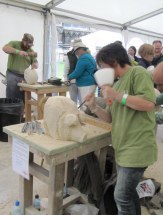
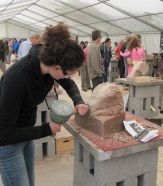 I was also surprised, and delighted to see so many women taking part, and that generally the age-range was so young. This is Jennifer Jordan from Great Britain. There are clearly a lot of very skilled craftsmen out there.
I was also surprised, and delighted to see so many women taking part, and that generally the age-range was so young. This is Jennifer Jordan from Great Britain. There are clearly a lot of very skilled craftsmen out there.
This afternoon (23rd June 2013) everyone will down tools at 2.15pm and all the finished work will be put on display with prizes awarded for the best. Then at 3 pm there will be an auction with all proceeds going to Lincoln Cathedral Fabric Fund to help towards the costs of the event.
It would be so lovely to own such a unique piece of art, but unfortunately I think it would be out of my price range. However, I was so glad to have attended such a unique event*** For more about my writing just click here

 Lincoln Cathedral was the dramatic setting for this amazing event. Held annually since 1999, it is hosted in a different country each year. It was the first time the event had been held in the UK for ten years, and was with a free entry - so far too good to miss!
Lincoln Cathedral was the dramatic setting for this amazing event. Held annually since 1999, it is hosted in a different country each year. It was the first time the event had been held in the UK for ten years, and was with a free entry - so far too good to miss!The first thing that struck me was the noise! Up to 140 masons were bashing away with hammers and chisels, with pieces of stone flying in all directions! (I was glad when someone kindly pointed out a box near the entrance full of complimentary goggles!)

 Each workstation (made of piled up breeze blocks I noticed!) was clearly labeled, and this is Liebert Benjamin carefully measuring his work. At the end of the afternoon I returned and it was absolutely fascinating to see how the works had progressed.)
Each workstation (made of piled up breeze blocks I noticed!) was clearly labeled, and this is Liebert Benjamin carefully measuring his work. At the end of the afternoon I returned and it was absolutely fascinating to see how the works had progressed.)Each mason was given the task of creating an individual piece on the theme of 'Food and Farming', and it was amazing how many had chosen to create pigs!

 I was also surprised, and delighted to see so many women taking part, and that generally the age-range was so young. This is Jennifer Jordan from Great Britain. There are clearly a lot of very skilled craftsmen out there.
I was also surprised, and delighted to see so many women taking part, and that generally the age-range was so young. This is Jennifer Jordan from Great Britain. There are clearly a lot of very skilled craftsmen out there.This afternoon (23rd June 2013) everyone will down tools at 2.15pm and all the finished work will be put on display with prizes awarded for the best. Then at 3 pm there will be an auction with all proceeds going to Lincoln Cathedral Fabric Fund to help towards the costs of the event.
It would be so lovely to own such a unique piece of art, but unfortunately I think it would be out of my price range. However, I was so glad to have attended such a unique event*** For more about my writing just click here

Published on June 22, 2013 23:43
June 21, 2013
St Martins-in-the-Fields cafe - Trafalgar Square - London
http://www.aboutnottinghamshire.co.uk/
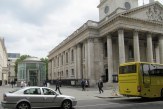
 This is one of my favourite places in eat in London, and it's such a handy location being on the edge of Trafalgar Square! The entrance is via the glass entrance right next to the striking church, and there's a lift as well as curving stairs.
This is one of my favourite places in eat in London, and it's such a handy location being on the edge of Trafalgar Square! The entrance is via the glass entrance right next to the striking church, and there's a lift as well as curving stairs.
Then it's through the most interesting shop and box office (the church holds the most amazing concerts - often by candle light, which are well worth attending) and straight on into the crypt of the church. This is packed with tables and chairs with a serving hatch at the far end. (I just love looking up at the intricate brickwork in the curved ceiling here!)
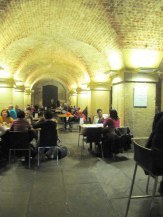
 Last visit I had roasted bubble and squeak with salad, and very tasty it was too! (Free jugs of water are available at the til - which is always worth knowing!) It's open every day (except Sunday) from 8am, til late in the evening. On Sundays its open 11 am til 6pm. Wednesday it's til 10.30pm, but from 6.30pm onwards its Jazz ticket holders only - now that's an evening I really fancy!!
Last visit I had roasted bubble and squeak with salad, and very tasty it was too! (Free jugs of water are available at the til - which is always worth knowing!) It's open every day (except Sunday) from 8am, til late in the evening. On Sundays its open 11 am til 6pm. Wednesday it's til 10.30pm, but from 6.30pm onwards its Jazz ticket holders only - now that's an evening I really fancy!!
All profits from the cafe, shop and concerts fund the work of St Martin-in-the-Fields, yet another excellent reason to call in and treat yourself to something lovely!
For more about my books just click here


 This is one of my favourite places in eat in London, and it's such a handy location being on the edge of Trafalgar Square! The entrance is via the glass entrance right next to the striking church, and there's a lift as well as curving stairs.
This is one of my favourite places in eat in London, and it's such a handy location being on the edge of Trafalgar Square! The entrance is via the glass entrance right next to the striking church, and there's a lift as well as curving stairs.Then it's through the most interesting shop and box office (the church holds the most amazing concerts - often by candle light, which are well worth attending) and straight on into the crypt of the church. This is packed with tables and chairs with a serving hatch at the far end. (I just love looking up at the intricate brickwork in the curved ceiling here!)

 Last visit I had roasted bubble and squeak with salad, and very tasty it was too! (Free jugs of water are available at the til - which is always worth knowing!) It's open every day (except Sunday) from 8am, til late in the evening. On Sundays its open 11 am til 6pm. Wednesday it's til 10.30pm, but from 6.30pm onwards its Jazz ticket holders only - now that's an evening I really fancy!!
Last visit I had roasted bubble and squeak with salad, and very tasty it was too! (Free jugs of water are available at the til - which is always worth knowing!) It's open every day (except Sunday) from 8am, til late in the evening. On Sundays its open 11 am til 6pm. Wednesday it's til 10.30pm, but from 6.30pm onwards its Jazz ticket holders only - now that's an evening I really fancy!! All profits from the cafe, shop and concerts fund the work of St Martin-in-the-Fields, yet another excellent reason to call in and treat yourself to something lovely!
For more about my books just click here

Published on June 21, 2013 09:12
June 19, 2013
Sculptures - Festival of Neighbourhood - South Bank - London
http://www.aboutnottinghamshire.co.uk/
It was a small piece in a local newspaper that made me aware of these unusual sculptures, so on a recent trip to London I was determined to find them.
They were made by Pirate Technics, a firm based in Screveton, Nottinghamshire. It took eight artist six weeks designing the four figures, which now take part in London's Southbank Centre's Festival of Neighbourhood.
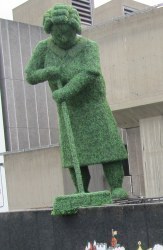
 These two figures, with the tallest standing some 23 feet tall, represent an old woman and a young boy and have been dubbed The Sweepers. They were made to celebrate the community spirit that followed the London riots two years ago, when neighbours helped each other by sweeping up the mess. Each has a metal pole through the bodies to keep them upright, and are made by internal scaffolding supported by timber. This has been encased in chicken wire before being decorated with artificial topiary.
These two figures, with the tallest standing some 23 feet tall, represent an old woman and a young boy and have been dubbed The Sweepers. They were made to celebrate the community spirit that followed the London riots two years ago, when neighbours helped each other by sweeping up the mess. Each has a metal pole through the bodies to keep them upright, and are made by internal scaffolding supported by timber. This has been encased in chicken wire before being decorated with artificial topiary.
I first spotted these two whilst walking along the South Bank of the River Thames, near to the Festival Hall, and then realised that they looked even better from Hungerford Bridge. With thousands of people passing by each day, it's a case of 'well done - the skilled people of Nottinghamshire'!
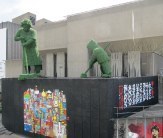 For more about me and my writing just click here
For more about me and my writing just click here

It was a small piece in a local newspaper that made me aware of these unusual sculptures, so on a recent trip to London I was determined to find them.
They were made by Pirate Technics, a firm based in Screveton, Nottinghamshire. It took eight artist six weeks designing the four figures, which now take part in London's Southbank Centre's Festival of Neighbourhood.

 These two figures, with the tallest standing some 23 feet tall, represent an old woman and a young boy and have been dubbed The Sweepers. They were made to celebrate the community spirit that followed the London riots two years ago, when neighbours helped each other by sweeping up the mess. Each has a metal pole through the bodies to keep them upright, and are made by internal scaffolding supported by timber. This has been encased in chicken wire before being decorated with artificial topiary.
These two figures, with the tallest standing some 23 feet tall, represent an old woman and a young boy and have been dubbed The Sweepers. They were made to celebrate the community spirit that followed the London riots two years ago, when neighbours helped each other by sweeping up the mess. Each has a metal pole through the bodies to keep them upright, and are made by internal scaffolding supported by timber. This has been encased in chicken wire before being decorated with artificial topiary.I first spotted these two whilst walking along the South Bank of the River Thames, near to the Festival Hall, and then realised that they looked even better from Hungerford Bridge. With thousands of people passing by each day, it's a case of 'well done - the skilled people of Nottinghamshire'!
 For more about me and my writing just click here
For more about me and my writing just click here
Published on June 19, 2013 05:49
June 16, 2013
Overground Underground - Ecton Mine - Peak District
http://www.aboutnottinghamshire.co.uk/
Ecton is a few miles west of Hartington, in a really isolated location - I did a recce before the visit as it's not the easiest place to find! The Education Centre is used by schools and colleges, but I think the facility is only occasionally available for member of the National Trust. The mine's heyday was between 1760 and 1790 when vast deposits of high grade copper was extracted, making the 5th Duke of Devonshire so wealthy he built the famous Buxton Crescent and Stable Block with the profits!
 We were greeted at the car parking area by a volunteer, and directed up a very steep incline to the Centre. There hot drinks and biscuits were waiting for us in a nice room, which had running water and toilet facilities. Then our group of some 20 souls, all suitably equipped with warm waterproof clothing and sturdy footwear, as per the instruction sheet, were divided into two groups. I was in the 'underground' section, and we were taken into the 'lamp room' to be fitted with hard hats, each with a light on the front, this being the sole illumination whilst underground.
We were greeted at the car parking area by a volunteer, and directed up a very steep incline to the Centre. There hot drinks and biscuits were waiting for us in a nice room, which had running water and toilet facilities. Then our group of some 20 souls, all suitably equipped with warm waterproof clothing and sturdy footwear, as per the instruction sheet, were divided into two groups. I was in the 'underground' section, and we were taken into the 'lamp room' to be fitted with hard hats, each with a light on the front, this being the sole illumination whilst underground.
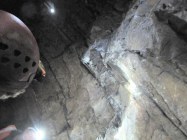 Then it was off into the mine, which had been cut straight into the hillside. I found the roof quite low, and it did necessitate stooping most of the way, and the path, whilst quite level was full of puddles and the occasional rock! Periodically we stopped to be shown points of interest by our very enthusiastic guide and accompanying volunteer.
Then it was off into the mine, which had been cut straight into the hillside. I found the roof quite low, and it did necessitate stooping most of the way, and the path, whilst quite level was full of puddles and the occasional rock! Periodically we stopped to be shown points of interest by our very enthusiastic guide and accompanying volunteer.
Altogether we must have been underground for around an hour and a half, before we retraced our footsteps back to the centre, to eat out packed lunch and have a hot drink. (The mine is at a constant temperature of 11 degrees, so was quite chilly.)
Then it was time to go outside, and it was good to see the sunshine, and to appreciate the appalling working conditions of the 18th century miners, although the copper had been mined as far back as the Bronze Age.
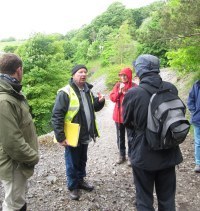
 We again started with interesting information, before heading up the hill behind the Education Centre. The instruction sheet stated this would 'involve a walk of about 1 mile, taken at a steady pace upon onto the hill itself, involving a moderate ascent with stops.' I don't know that I would quite agree with this description, it was in fact an extremely steep climb and we ended up even higher than a buzzard gently circling the valley way below!
We again started with interesting information, before heading up the hill behind the Education Centre. The instruction sheet stated this would 'involve a walk of about 1 mile, taken at a steady pace upon onto the hill itself, involving a moderate ascent with stops.' I don't know that I would quite agree with this description, it was in fact an extremely steep climb and we ended up even higher than a buzzard gently circling the valley way below!
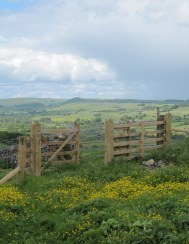 On the walk we visited the engine house, and walked on to other mining sites on this mineral-rich hill, before walking back to the centre.
On the walk we visited the engine house, and walked on to other mining sites on this mineral-rich hill, before walking back to the centre.
This had been an amazing experience and I wouldn't have missed it for anything, although I did feel you had to be pretty fit and able-bodied, and not be worried by wet, confined spaces!
What made the day was the sheer knowledge and enthusiasm of the guides, both employed and volunteers who definitely made the day so special.
For more about me and my writing just click here

Ecton is a few miles west of Hartington, in a really isolated location - I did a recce before the visit as it's not the easiest place to find! The Education Centre is used by schools and colleges, but I think the facility is only occasionally available for member of the National Trust. The mine's heyday was between 1760 and 1790 when vast deposits of high grade copper was extracted, making the 5th Duke of Devonshire so wealthy he built the famous Buxton Crescent and Stable Block with the profits!
 We were greeted at the car parking area by a volunteer, and directed up a very steep incline to the Centre. There hot drinks and biscuits were waiting for us in a nice room, which had running water and toilet facilities. Then our group of some 20 souls, all suitably equipped with warm waterproof clothing and sturdy footwear, as per the instruction sheet, were divided into two groups. I was in the 'underground' section, and we were taken into the 'lamp room' to be fitted with hard hats, each with a light on the front, this being the sole illumination whilst underground.
We were greeted at the car parking area by a volunteer, and directed up a very steep incline to the Centre. There hot drinks and biscuits were waiting for us in a nice room, which had running water and toilet facilities. Then our group of some 20 souls, all suitably equipped with warm waterproof clothing and sturdy footwear, as per the instruction sheet, were divided into two groups. I was in the 'underground' section, and we were taken into the 'lamp room' to be fitted with hard hats, each with a light on the front, this being the sole illumination whilst underground.  Then it was off into the mine, which had been cut straight into the hillside. I found the roof quite low, and it did necessitate stooping most of the way, and the path, whilst quite level was full of puddles and the occasional rock! Periodically we stopped to be shown points of interest by our very enthusiastic guide and accompanying volunteer.
Then it was off into the mine, which had been cut straight into the hillside. I found the roof quite low, and it did necessitate stooping most of the way, and the path, whilst quite level was full of puddles and the occasional rock! Periodically we stopped to be shown points of interest by our very enthusiastic guide and accompanying volunteer.Altogether we must have been underground for around an hour and a half, before we retraced our footsteps back to the centre, to eat out packed lunch and have a hot drink. (The mine is at a constant temperature of 11 degrees, so was quite chilly.)
Then it was time to go outside, and it was good to see the sunshine, and to appreciate the appalling working conditions of the 18th century miners, although the copper had been mined as far back as the Bronze Age.

 We again started with interesting information, before heading up the hill behind the Education Centre. The instruction sheet stated this would 'involve a walk of about 1 mile, taken at a steady pace upon onto the hill itself, involving a moderate ascent with stops.' I don't know that I would quite agree with this description, it was in fact an extremely steep climb and we ended up even higher than a buzzard gently circling the valley way below!
We again started with interesting information, before heading up the hill behind the Education Centre. The instruction sheet stated this would 'involve a walk of about 1 mile, taken at a steady pace upon onto the hill itself, involving a moderate ascent with stops.' I don't know that I would quite agree with this description, it was in fact an extremely steep climb and we ended up even higher than a buzzard gently circling the valley way below!
 On the walk we visited the engine house, and walked on to other mining sites on this mineral-rich hill, before walking back to the centre.
On the walk we visited the engine house, and walked on to other mining sites on this mineral-rich hill, before walking back to the centre.This had been an amazing experience and I wouldn't have missed it for anything, although I did feel you had to be pretty fit and able-bodied, and not be worried by wet, confined spaces!
What made the day was the sheer knowledge and enthusiasm of the guides, both employed and volunteers who definitely made the day so special.
For more about me and my writing just click here

Published on June 16, 2013 03:14
June 11, 2013
Melbourne Hall Gardens - Melbourne - Derbyshire
http://www.aboutnottinghamshire.co.uk/
 I'd never been to this place, so seeing it was open under the wonderful National Gardens Scheme, I couldn't wait to visit!
I'd never been to this place, so seeing it was open under the wonderful National Gardens Scheme, I couldn't wait to visit!
You enter through a courtyard, and on one side are various little independent outlets, which I always enjoy, and then its into the magical world of of an 18th century garden. The original design dates from 1704, reflecting the enthusiasm of the Rt. Hon. Thomas Coke. He had inherited the property in 1696 and later he became Vice Chamberlain to Queen Anne and George 1. In his youth he had often been to Europe where he was impressed by the Dutch style of gardens he had seen there.
These restored gardens show the influence of the formal style in favour at the time, and are considered the best surviving example of the famous designer Le Notre to be seen in England today.

 There was just so much to explore and marvellous at, and all in such a quiet tranquil atmosphere, all beautifully maintained. I particularly liked all the water features - in fact I'd never seen a row of fountains like this before, but it was most effective. The beautiful 'Bird Cage' was amazing, at the end of a long vista.
There was just so much to explore and marvellous at, and all in such a quiet tranquil atmosphere, all beautifully maintained. I particularly liked all the water features - in fact I'd never seen a row of fountains like this before, but it was most effective. The beautiful 'Bird Cage' was amazing, at the end of a long vista.
On the edge of the property is a large reservoir, clearly much enjoyed by the locals. A notice said the wrought iron balustrade was the work of the celebrated smith Robert Bakewell of Derby and was restored in 1994 with a generous grant from the Worshipful Company of Ironmongers.

I really loved my visit to this magical place, even though the signage to find it could have been better (it's right in the middle of the town) and parking was a nightmare! Now I'm really looking forward to going back during August when the Hall is open to the public, and also revisiting the cafe, about which I will be doing a subsequent blog.
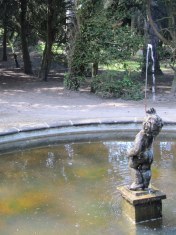 ***For more about me and my writing just click here
***For more about me and my writing just click here

 I'd never been to this place, so seeing it was open under the wonderful National Gardens Scheme, I couldn't wait to visit!
I'd never been to this place, so seeing it was open under the wonderful National Gardens Scheme, I couldn't wait to visit!You enter through a courtyard, and on one side are various little independent outlets, which I always enjoy, and then its into the magical world of of an 18th century garden. The original design dates from 1704, reflecting the enthusiasm of the Rt. Hon. Thomas Coke. He had inherited the property in 1696 and later he became Vice Chamberlain to Queen Anne and George 1. In his youth he had often been to Europe where he was impressed by the Dutch style of gardens he had seen there.
These restored gardens show the influence of the formal style in favour at the time, and are considered the best surviving example of the famous designer Le Notre to be seen in England today.

 There was just so much to explore and marvellous at, and all in such a quiet tranquil atmosphere, all beautifully maintained. I particularly liked all the water features - in fact I'd never seen a row of fountains like this before, but it was most effective. The beautiful 'Bird Cage' was amazing, at the end of a long vista.
There was just so much to explore and marvellous at, and all in such a quiet tranquil atmosphere, all beautifully maintained. I particularly liked all the water features - in fact I'd never seen a row of fountains like this before, but it was most effective. The beautiful 'Bird Cage' was amazing, at the end of a long vista.On the edge of the property is a large reservoir, clearly much enjoyed by the locals. A notice said the wrought iron balustrade was the work of the celebrated smith Robert Bakewell of Derby and was restored in 1994 with a generous grant from the Worshipful Company of Ironmongers.

I really loved my visit to this magical place, even though the signage to find it could have been better (it's right in the middle of the town) and parking was a nightmare! Now I'm really looking forward to going back during August when the Hall is open to the public, and also revisiting the cafe, about which I will be doing a subsequent blog.
 ***For more about me and my writing just click here
***For more about me and my writing just click here
Published on June 11, 2013 03:29
June 4, 2013
'Houghton Revisited' - Houghton Hall - Norfolk
http://www.aboutnottinghamshire.co.uk/
This was my second visit to lovely Houghton Hall and it was as breathtaking as I remembered, with vast parkland and lovely gardens, not to mention the stunning house itself.
This time I had come solely to see the exhibition 'Houghton Revisited', and I could hardly wait! It came about because Britain's first Prime Minister, Sir Robert Walpole (1676 - 1745) had surrounded himself with treasured possessions, which included marvellous works of art. Tragically his grandson gambled away the family fortune, and it was only the sale of the entire collection to Catherine the Great, Empress of Russia, that saved the day. She wanted the paintings for the 'Hermitage' in the Winter Palace in St. Petersburg.
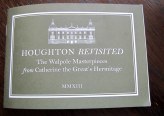 Now, for a short time only, the priceless paintings have returned to Houghton, carefully hung in their original position.
Now, for a short time only, the priceless paintings have returned to Houghton, carefully hung in their original position.
Each person is given a small booklet on arrival, which I enjoyed studying on returning home, although at the time I preferred to talk to the knowledgeable stewards, who were available in every room. (Houghton in so marvellous because due to it's very chequered history, it was kept in storage for some 150 years, and is still in near-pristine condition. The colours in the Mortlake tapestries and some of the furnishings are amazing.)
As expected photography was not allowed, so the illustrations here are postcards, and pictures taken from magazine articles, as there has been quite a bit of press about this one-off event.
 I think my favourite was Carlo Maratta's 'Pope Clement IX' where you could almost feel the soft velvet of his cape but at the same time admire the delicate white lacework across his knees. The booklet reads 'The Pope sits on his throne with great dignity tempered by elderly ffrailty, weeks before his death. His penetrating gaze appears to fall upon the viewer with insightful benevolence.' I certainly could have stood and looked at it for hours it was so marvellous.
I think my favourite was Carlo Maratta's 'Pope Clement IX' where you could almost feel the soft velvet of his cape but at the same time admire the delicate white lacework across his knees. The booklet reads 'The Pope sits on his throne with great dignity tempered by elderly ffrailty, weeks before his death. His penetrating gaze appears to fall upon the viewer with insightful benevolence.' I certainly could have stood and looked at it for hours it was so marvellous.
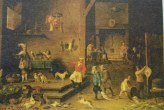 I also liked 'The Kitchen' by David Teniers (1646) which measures more than 7 feet across and contained so much it really needed a lot of time to study it properly.
I also liked 'The Kitchen' by David Teniers (1646) which measures more than 7 feet across and contained so much it really needed a lot of time to study it properly.
I thought this was the most marvellous exhibition, and I was very thrilled to have been able to attend. Truly a once in a lifetime experience.This is a timed exhibition so tickets need to be booked in advance, and it continues until September.
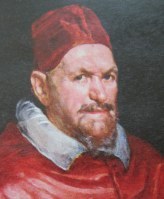 Portrait of Pope Innocent X (x 1650)Diego Rodriguez de Silva Velazquez ***For more about me, just click here
Portrait of Pope Innocent X (x 1650)Diego Rodriguez de Silva Velazquez ***For more about me, just click here

This was my second visit to lovely Houghton Hall and it was as breathtaking as I remembered, with vast parkland and lovely gardens, not to mention the stunning house itself.
This time I had come solely to see the exhibition 'Houghton Revisited', and I could hardly wait! It came about because Britain's first Prime Minister, Sir Robert Walpole (1676 - 1745) had surrounded himself with treasured possessions, which included marvellous works of art. Tragically his grandson gambled away the family fortune, and it was only the sale of the entire collection to Catherine the Great, Empress of Russia, that saved the day. She wanted the paintings for the 'Hermitage' in the Winter Palace in St. Petersburg.
 Now, for a short time only, the priceless paintings have returned to Houghton, carefully hung in their original position.
Now, for a short time only, the priceless paintings have returned to Houghton, carefully hung in their original position. Each person is given a small booklet on arrival, which I enjoyed studying on returning home, although at the time I preferred to talk to the knowledgeable stewards, who were available in every room. (Houghton in so marvellous because due to it's very chequered history, it was kept in storage for some 150 years, and is still in near-pristine condition. The colours in the Mortlake tapestries and some of the furnishings are amazing.)
As expected photography was not allowed, so the illustrations here are postcards, and pictures taken from magazine articles, as there has been quite a bit of press about this one-off event.
 I think my favourite was Carlo Maratta's 'Pope Clement IX' where you could almost feel the soft velvet of his cape but at the same time admire the delicate white lacework across his knees. The booklet reads 'The Pope sits on his throne with great dignity tempered by elderly ffrailty, weeks before his death. His penetrating gaze appears to fall upon the viewer with insightful benevolence.' I certainly could have stood and looked at it for hours it was so marvellous.
I think my favourite was Carlo Maratta's 'Pope Clement IX' where you could almost feel the soft velvet of his cape but at the same time admire the delicate white lacework across his knees. The booklet reads 'The Pope sits on his throne with great dignity tempered by elderly ffrailty, weeks before his death. His penetrating gaze appears to fall upon the viewer with insightful benevolence.' I certainly could have stood and looked at it for hours it was so marvellous. I also liked 'The Kitchen' by David Teniers (1646) which measures more than 7 feet across and contained so much it really needed a lot of time to study it properly.
I also liked 'The Kitchen' by David Teniers (1646) which measures more than 7 feet across and contained so much it really needed a lot of time to study it properly.I thought this was the most marvellous exhibition, and I was very thrilled to have been able to attend. Truly a once in a lifetime experience.This is a timed exhibition so tickets need to be booked in advance, and it continues until September.
 Portrait of Pope Innocent X (x 1650)Diego Rodriguez de Silva Velazquez ***For more about me, just click here
Portrait of Pope Innocent X (x 1650)Diego Rodriguez de Silva Velazquez ***For more about me, just click here
Published on June 04, 2013 01:04
May 29, 2013
Bamford Sheepdog Trials -
http://www.aboutnottinghamshire.co.uk/
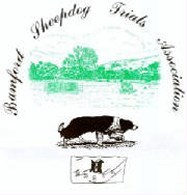 Bamford is situated in the beautiful Derbyshire Peak District, and I couldn't think of a lovelier place to hold Sheepdog Trials. That I hadn't been before was a serious mistake.
Bamford is situated in the beautiful Derbyshire Peak District, and I couldn't think of a lovelier place to hold Sheepdog Trials. That I hadn't been before was a serious mistake.
The event is small, which certainly added to it's charm, but very well organised. I was directed to car parking, and then it was a short walk back to the large open area to be used for the trials. A few orange plastic chairs had been arranged along the barrier, but these were quite wet - it's always best to bring your own seating! There was the expected van selling chips, bacon cobs etc., and very necessary hot drinks, as the wind was biting, although the sunshine was lovely. There was also a tent selling home-made cakes and cards.
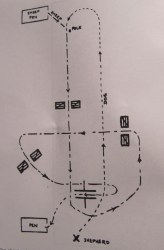
What I particularly enjoyed was the excellent sound system, and the detailed programme, which not only gave a clear running order but a map of the complicated course. Altogether a brilliant day, and I look forward to coming back next year when hopefully the wind will be less chilly!
As President Trudi Hodges wrote in the programme 'I believe that it is important to support and further local traditions and events and to maintain and encourage the skills that we can all see at Bamford Sheepdog Trials.' I go along with that!
 For more about me just click here
For more about me just click here

 Bamford is situated in the beautiful Derbyshire Peak District, and I couldn't think of a lovelier place to hold Sheepdog Trials. That I hadn't been before was a serious mistake.
Bamford is situated in the beautiful Derbyshire Peak District, and I couldn't think of a lovelier place to hold Sheepdog Trials. That I hadn't been before was a serious mistake.The event is small, which certainly added to it's charm, but very well organised. I was directed to car parking, and then it was a short walk back to the large open area to be used for the trials. A few orange plastic chairs had been arranged along the barrier, but these were quite wet - it's always best to bring your own seating! There was the expected van selling chips, bacon cobs etc., and very necessary hot drinks, as the wind was biting, although the sunshine was lovely. There was also a tent selling home-made cakes and cards.

What I particularly enjoyed was the excellent sound system, and the detailed programme, which not only gave a clear running order but a map of the complicated course. Altogether a brilliant day, and I look forward to coming back next year when hopefully the wind will be less chilly!
As President Trudi Hodges wrote in the programme 'I believe that it is important to support and further local traditions and events and to maintain and encourage the skills that we can all see at Bamford Sheepdog Trials.' I go along with that!
 For more about me just click here
For more about me just click here 
Published on May 29, 2013 00:02
May 27, 2013
Freshfields 'The Actors' Donkey Village - Peak Forest - Derbyshire
http://www.aboutnottinghamshire.co.uk/
 This amazing place is only five miles from the busy town of Buxton, and not far from Castleton, but it could be another world. I had never visited before, and had little idea what to expect, but as I wove along the narrow lanes it became obvious that it was both very rural and in the most beautiful setting.
This amazing place is only five miles from the busy town of Buxton, and not far from Castleton, but it could be another world. I had never visited before, and had little idea what to expect, but as I wove along the narrow lanes it became obvious that it was both very rural and in the most beautiful setting.
The Michael Elliott Trust was founded in 1991 with the twin aims of providing a sanctuary for abused donkeys and a safe place for special needs children to feed, groom and care for an animal during their visit.
It has been supported by all the leading luminaires in the theatre world, like Sir Lawrence Olivier, Sir John Mills as well as Dame Judi Dench, Albert Finney and Vanessa Redgrave to name just a few.
 The first thing that struck me, apart from the beautiful setting, was the quiet, tranquil atmosphere. The place was spotlessly clean, and we were shown round by John Stirling, who rescued his first donkey in 1988! This is the dormitory where the animals come in on cold nights. On each was pinned a most interest biography
The first thing that struck me, apart from the beautiful setting, was the quiet, tranquil atmosphere. The place was spotlessly clean, and we were shown round by John Stirling, who rescued his first donkey in 1988! This is the dormitory where the animals come in on cold nights. On each was pinned a most interest biography
This is Paphos:
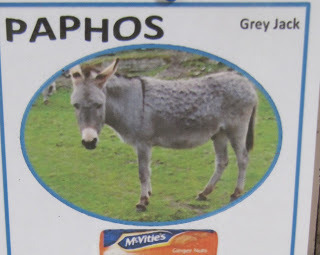 'I was rescued from Cyprus along with my best friend Sky when we were 3 months old. My mother had been thrown over a cliff and killed (the common fate for unwanted animals in Cyprus) leaving me heartbroken and terrified alone with no milk to keep me alive. Martin Shaw & Jenny Seagrove met us at Manchester Airport on arrival but I had never seen grass or very many donkeys so arriving at Donkey Village was very frightening. Sky and I feel more like brothers and we often play fight together. I am very affectionate but I will try to explore your bags. I love ginger nut biscuits added in my bucket feed.'
'I was rescued from Cyprus along with my best friend Sky when we were 3 months old. My mother had been thrown over a cliff and killed (the common fate for unwanted animals in Cyprus) leaving me heartbroken and terrified alone with no milk to keep me alive. Martin Shaw & Jenny Seagrove met us at Manchester Airport on arrival but I had never seen grass or very many donkeys so arriving at Donkey Village was very frightening. Sky and I feel more like brothers and we often play fight together. I am very affectionate but I will try to explore your bags. I love ginger nut biscuits added in my bucket feed.'
This is Blue
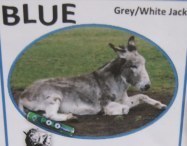 'I was spotted by a tourist when I was working with my friend Rhapsody pulling carts in Hungary. We were both in very bad condition with skin and foot problems and had ill fitting harnesses that were painful to wear. The tourist bought us and shipped us to UK before finding us our home here at Donkey Village. We were very scared and I still require sedation when any treatment is carried out on my feet but I am getting better and have discovered I love polo mints, they make my backet feed taste good. I am friendly to visitors but will walk away when I want to be left alone.'
'I was spotted by a tourist when I was working with my friend Rhapsody pulling carts in Hungary. We were both in very bad condition with skin and foot problems and had ill fitting harnesses that were painful to wear. The tourist bought us and shipped us to UK before finding us our home here at Donkey Village. We were very scared and I still require sedation when any treatment is carried out on my feet but I am getting better and have discovered I love polo mints, they make my backet feed taste good. I am friendly to visitors but will walk away when I want to be left alone.'
Visitors are encouraged to mingle with the donkey, although food of any kind (including Polo mints) must be removed from bags and pockets first!
In addition to all this care thousands of disabled children come and learn how to look after these delightful animals - for once they are the 'carers' even if their own needs are considerable.
I thought this the most wonderful place. I particularly loved the freedom these abused animals now enjoyed with vast areas to roam as they wished.
Even at night, during the mild months, they chose whether to come inside or wander around on all the grass.
Now I can't wait to go back and spend time in such a very special place.
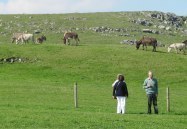 To see more of my writing just click here
To see more of my writing just click here

 This amazing place is only five miles from the busy town of Buxton, and not far from Castleton, but it could be another world. I had never visited before, and had little idea what to expect, but as I wove along the narrow lanes it became obvious that it was both very rural and in the most beautiful setting.
This amazing place is only five miles from the busy town of Buxton, and not far from Castleton, but it could be another world. I had never visited before, and had little idea what to expect, but as I wove along the narrow lanes it became obvious that it was both very rural and in the most beautiful setting.The Michael Elliott Trust was founded in 1991 with the twin aims of providing a sanctuary for abused donkeys and a safe place for special needs children to feed, groom and care for an animal during their visit.
It has been supported by all the leading luminaires in the theatre world, like Sir Lawrence Olivier, Sir John Mills as well as Dame Judi Dench, Albert Finney and Vanessa Redgrave to name just a few.
 The first thing that struck me, apart from the beautiful setting, was the quiet, tranquil atmosphere. The place was spotlessly clean, and we were shown round by John Stirling, who rescued his first donkey in 1988! This is the dormitory where the animals come in on cold nights. On each was pinned a most interest biography
The first thing that struck me, apart from the beautiful setting, was the quiet, tranquil atmosphere. The place was spotlessly clean, and we were shown round by John Stirling, who rescued his first donkey in 1988! This is the dormitory where the animals come in on cold nights. On each was pinned a most interest biographyThis is Paphos:
 'I was rescued from Cyprus along with my best friend Sky when we were 3 months old. My mother had been thrown over a cliff and killed (the common fate for unwanted animals in Cyprus) leaving me heartbroken and terrified alone with no milk to keep me alive. Martin Shaw & Jenny Seagrove met us at Manchester Airport on arrival but I had never seen grass or very many donkeys so arriving at Donkey Village was very frightening. Sky and I feel more like brothers and we often play fight together. I am very affectionate but I will try to explore your bags. I love ginger nut biscuits added in my bucket feed.'
'I was rescued from Cyprus along with my best friend Sky when we were 3 months old. My mother had been thrown over a cliff and killed (the common fate for unwanted animals in Cyprus) leaving me heartbroken and terrified alone with no milk to keep me alive. Martin Shaw & Jenny Seagrove met us at Manchester Airport on arrival but I had never seen grass or very many donkeys so arriving at Donkey Village was very frightening. Sky and I feel more like brothers and we often play fight together. I am very affectionate but I will try to explore your bags. I love ginger nut biscuits added in my bucket feed.'This is Blue
 'I was spotted by a tourist when I was working with my friend Rhapsody pulling carts in Hungary. We were both in very bad condition with skin and foot problems and had ill fitting harnesses that were painful to wear. The tourist bought us and shipped us to UK before finding us our home here at Donkey Village. We were very scared and I still require sedation when any treatment is carried out on my feet but I am getting better and have discovered I love polo mints, they make my backet feed taste good. I am friendly to visitors but will walk away when I want to be left alone.'
'I was spotted by a tourist when I was working with my friend Rhapsody pulling carts in Hungary. We were both in very bad condition with skin and foot problems and had ill fitting harnesses that were painful to wear. The tourist bought us and shipped us to UK before finding us our home here at Donkey Village. We were very scared and I still require sedation when any treatment is carried out on my feet but I am getting better and have discovered I love polo mints, they make my backet feed taste good. I am friendly to visitors but will walk away when I want to be left alone.'Visitors are encouraged to mingle with the donkey, although food of any kind (including Polo mints) must be removed from bags and pockets first!
In addition to all this care thousands of disabled children come and learn how to look after these delightful animals - for once they are the 'carers' even if their own needs are considerable.
I thought this the most wonderful place. I particularly loved the freedom these abused animals now enjoyed with vast areas to roam as they wished.
Even at night, during the mild months, they chose whether to come inside or wander around on all the grass.
Now I can't wait to go back and spend time in such a very special place.
 To see more of my writing just click here
To see more of my writing just click here
Published on May 27, 2013 23:20
May 14, 2013
The Bodging Project - Harley Gallery - Welbeck - Worksop - N. Nottinghamshire
http://www.aboutnottinghamshire.co.uk/
A fascinating new exhibition has just opened in the lovely Harley Gallery at Welbeck (See previous blog)
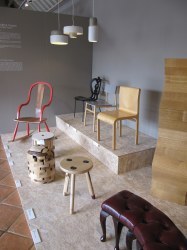
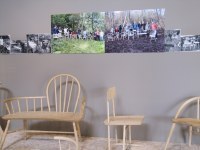
Called The Bodging Project it shows what happened when 10 renowned furniture designers went to a woodland workshop in Herefordshire armed with only simple sketches, traditional green woodworking tools and a time-frame of six days. The resulting new, experimental furniture was then shown in Milan at the Salone del Mobile
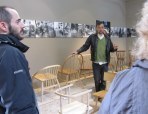 in 2010 and the London Design Fesitival 2012.
in 2010 and the London Design Fesitival 2012.
Very fortunately when I visited three of these very skilled craftsmen were on hand and gave a fascinating tour. The chair in the picture had evolved through various stages, and had been picked up at in Milan, was now being manufactured in China and was for sale in John Lewis stores. It certainly was gorgeous.
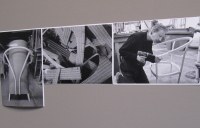 Upstairs the exhibition continued showing what happened when 5 designers, in June 2012, visited the closed Lloyd Loom factory in Spalding, Lincolnshire. Using the factory machinery and their signature weave (I'd forgotten Lloyd Loom is basically brown paper spun round wires), over 2 days, 13 completely new concepts were developed. These were left in the factory showroom for the staff to find on Monday morning - and what a lovely surprise they must have had!
Upstairs the exhibition continued showing what happened when 5 designers, in June 2012, visited the closed Lloyd Loom factory in Spalding, Lincolnshire. Using the factory machinery and their signature weave (I'd forgotten Lloyd Loom is basically brown paper spun round wires), over 2 days, 13 completely new concepts were developed. These were left in the factory showroom for the staff to find on Monday morning - and what a lovely surprise they must have had!
Several of these pieces are to go into production, and certainly all our tour group loved them and were anxious to know when they would be available in the shops. I've e-mailed Lloyd Loom for some dates, but so far have received no reply.
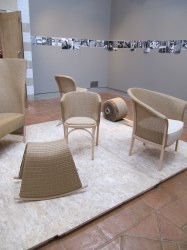 I loved this fascinating and very unusual exhibition, enhanced of course by actually speaking to the skilled craftspeople. It will be in the Harley Gallery until the 2nd June 2012
I loved this fascinating and very unusual exhibition, enhanced of course by actually speaking to the skilled craftspeople. It will be in the Harley Gallery until the 2nd June 2012
***
For more about my writing just click here

A fascinating new exhibition has just opened in the lovely Harley Gallery at Welbeck (See previous blog)


Called The Bodging Project it shows what happened when 10 renowned furniture designers went to a woodland workshop in Herefordshire armed with only simple sketches, traditional green woodworking tools and a time-frame of six days. The resulting new, experimental furniture was then shown in Milan at the Salone del Mobile
 in 2010 and the London Design Fesitival 2012.
in 2010 and the London Design Fesitival 2012.Very fortunately when I visited three of these very skilled craftsmen were on hand and gave a fascinating tour. The chair in the picture had evolved through various stages, and had been picked up at in Milan, was now being manufactured in China and was for sale in John Lewis stores. It certainly was gorgeous.
 Upstairs the exhibition continued showing what happened when 5 designers, in June 2012, visited the closed Lloyd Loom factory in Spalding, Lincolnshire. Using the factory machinery and their signature weave (I'd forgotten Lloyd Loom is basically brown paper spun round wires), over 2 days, 13 completely new concepts were developed. These were left in the factory showroom for the staff to find on Monday morning - and what a lovely surprise they must have had!
Upstairs the exhibition continued showing what happened when 5 designers, in June 2012, visited the closed Lloyd Loom factory in Spalding, Lincolnshire. Using the factory machinery and their signature weave (I'd forgotten Lloyd Loom is basically brown paper spun round wires), over 2 days, 13 completely new concepts were developed. These were left in the factory showroom for the staff to find on Monday morning - and what a lovely surprise they must have had!Several of these pieces are to go into production, and certainly all our tour group loved them and were anxious to know when they would be available in the shops. I've e-mailed Lloyd Loom for some dates, but so far have received no reply.
 I loved this fascinating and very unusual exhibition, enhanced of course by actually speaking to the skilled craftspeople. It will be in the Harley Gallery until the 2nd June 2012
I loved this fascinating and very unusual exhibition, enhanced of course by actually speaking to the skilled craftspeople. It will be in the Harley Gallery until the 2nd June 2012***
For more about my writing just click here

Published on May 14, 2013 23:55
May 12, 2013
OPAL East Midland Heathland Day - Edwinstowe - Nottinghamshire
http://www.aboutnottinghamshire.co.uk/
 This amazing course was held at Sherwood Visitors Centre in Edwinstowe and was run by an organisation called OPAL - which stands for The Open Air Laboratories network which was launched in 2007 following an award of £12 million from the Big Lottery Fund's £200 million 'Changing Spaces Programme'.
This amazing course was held at Sherwood Visitors Centre in Edwinstowe and was run by an organisation called OPAL - which stands for The Open Air Laboratories network which was launched in 2007 following an award of £12 million from the Big Lottery Fund's £200 million 'Changing Spaces Programme'.
The OPAL East Midlands project focused on the threatened heathland habitats in this region. I had no idea until this course that healthlands are rarer than rain forests, and back in 1980 it had had assessed that 95% of our heathlands had been lost. This situation was exacerbated in 2001 when the terrible foot and mouth outbreak meant that lifestock could not be moved around, resulting in the heather being overgrazed. Instead of different areas being grazed, large areas are now all of an equal growth, which is very bad for wildlife, who, we learnt, need a wide diversity of habitats to be successful.
In the morning there were fascinating talks with slides from experts Ed Tripp (Open Air Laboratories), Dr Roger Key (Senior Education Officer for Natural England), Andy Lowe (Notts Wildlife Trust) and Chris Monk (Derbyshire Amphibian and Reptile Group.) Each one told me something I never knew, and were engrossing speakers.
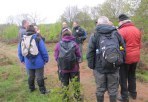
 After a lovely vegan lunch, it was a brisk walk to Budby Heath, an area of Special Scientific Interest.
After a lovely vegan lunch, it was a brisk walk to Budby Heath, an area of Special Scientific Interest.
There we had workshops and I had, with some difficulty as they all sounded so good, selected to go on the walk about birds called nightjars, and it was absolutely fascinating. What with deer, dogs, horses, cattle, sheep and tractors you really wondered how these precious ground-nesting birds ever survived!
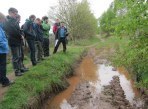
 The next workshop was called 'Surveying for healthland amphibians and reptiles' and Chris Monk was so wonderfully enthusiastic he would have made the dullest subject sound exciting!
The next workshop was called 'Surveying for healthland amphibians and reptiles' and Chris Monk was so wonderfully enthusiastic he would have made the dullest subject sound exciting!
Soon we were peering into puddles and looking under heather to discover bugs, and never before had I realised how exciting round holes could be! This one could well be the exit for a solitary bee, apparently a very important bug for pollination.
 This had been a simply marvellous day, and my only disappointment was that it would appear that this will be the last OPAL event in our area. It's felt really frustrating that I'd only just found them! However, it was better to have participated in one excellent course, than to have missed out altogether.
This had been a simply marvellous day, and my only disappointment was that it would appear that this will be the last OPAL event in our area. It's felt really frustrating that I'd only just found them! However, it was better to have participated in one excellent course, than to have missed out altogether.
If you would like to know more about me, and my many e-books just click here

 This amazing course was held at Sherwood Visitors Centre in Edwinstowe and was run by an organisation called OPAL - which stands for The Open Air Laboratories network which was launched in 2007 following an award of £12 million from the Big Lottery Fund's £200 million 'Changing Spaces Programme'.
This amazing course was held at Sherwood Visitors Centre in Edwinstowe and was run by an organisation called OPAL - which stands for The Open Air Laboratories network which was launched in 2007 following an award of £12 million from the Big Lottery Fund's £200 million 'Changing Spaces Programme'.The OPAL East Midlands project focused on the threatened heathland habitats in this region. I had no idea until this course that healthlands are rarer than rain forests, and back in 1980 it had had assessed that 95% of our heathlands had been lost. This situation was exacerbated in 2001 when the terrible foot and mouth outbreak meant that lifestock could not be moved around, resulting in the heather being overgrazed. Instead of different areas being grazed, large areas are now all of an equal growth, which is very bad for wildlife, who, we learnt, need a wide diversity of habitats to be successful.
In the morning there were fascinating talks with slides from experts Ed Tripp (Open Air Laboratories), Dr Roger Key (Senior Education Officer for Natural England), Andy Lowe (Notts Wildlife Trust) and Chris Monk (Derbyshire Amphibian and Reptile Group.) Each one told me something I never knew, and were engrossing speakers.

 After a lovely vegan lunch, it was a brisk walk to Budby Heath, an area of Special Scientific Interest.
After a lovely vegan lunch, it was a brisk walk to Budby Heath, an area of Special Scientific Interest.There we had workshops and I had, with some difficulty as they all sounded so good, selected to go on the walk about birds called nightjars, and it was absolutely fascinating. What with deer, dogs, horses, cattle, sheep and tractors you really wondered how these precious ground-nesting birds ever survived!

 The next workshop was called 'Surveying for healthland amphibians and reptiles' and Chris Monk was so wonderfully enthusiastic he would have made the dullest subject sound exciting!
The next workshop was called 'Surveying for healthland amphibians and reptiles' and Chris Monk was so wonderfully enthusiastic he would have made the dullest subject sound exciting!Soon we were peering into puddles and looking under heather to discover bugs, and never before had I realised how exciting round holes could be! This one could well be the exit for a solitary bee, apparently a very important bug for pollination.
 This had been a simply marvellous day, and my only disappointment was that it would appear that this will be the last OPAL event in our area. It's felt really frustrating that I'd only just found them! However, it was better to have participated in one excellent course, than to have missed out altogether.
This had been a simply marvellous day, and my only disappointment was that it would appear that this will be the last OPAL event in our area. It's felt really frustrating that I'd only just found them! However, it was better to have participated in one excellent course, than to have missed out altogether. If you would like to know more about me, and my many e-books just click here

Published on May 12, 2013 06:42



